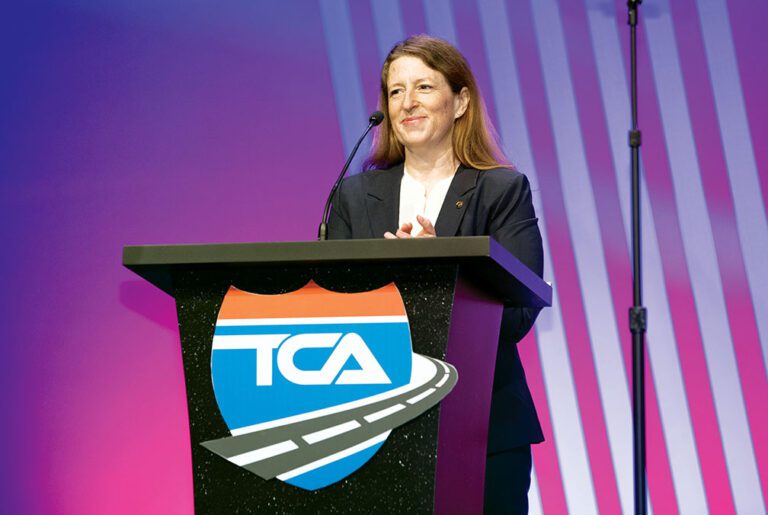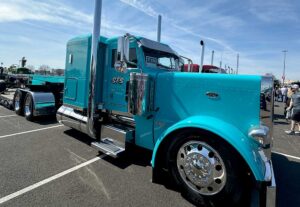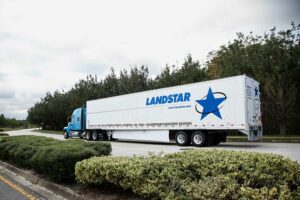When Federal Motor Carrier Safety Administration (FMCSA) Administrator Robin Hutcheson addressed Truckload Carriers Association members at this year’s annual convention, she touched on just about every issue of concern to drivers and industry leaders.
She also praised truck drivers for the sacrifices they make while out on the road each day.
“What drivers are doing for the American public is extraordinary; they are essential workers. They are keeping America moving every day,” Hutcheson said, noting that vital issues, such as a lack of safe parking, are at the forefront of FMCSA’s concerns.
On truck parking, Hutcheson pointed to the Bipartisan Infrastructure Plan, which has made millions of dollars in grant funds available to help states build more safe truck parking sites.
“We are pushing hard to progress on this issue,” she said. “We care deeply about truck parking.”
According to the American Trucking Associations, more than 98% percent of drivers report problems finding safe parking, burning more than 56 minutes of available drive-time every day to find it. That wasted time amounts to a $5,500 loss in annual compensation — or a 12% pay cut.
Hutcheson noted that her boss, Transportation Secretary Pete Buttigieg, has also pledged to make truck parking a priority. Last year, Buttigieg acknowledged during a hearing of the Senate’s Environment and Public Works Committee that a lack of safe truck parking is a serious issue that must be addressed.
“If you talk with any truck driver, it’s not only an issue of convenience, it’s an issue of safety,” Buttigieg said during that meeting. “And, I might add, with the idling that goes on, it’s even an issue of emissions.”
Switching topics, Hutcheson outlined some of what President Joe Biden’s Trucking Action Plan will entail for the trucking industry.
For example, more than $44 million in grants that will enhance road safety and make the process to obtain a CDL more efficient have been made available thanks to the plan, Hutcheson said.
Hutcheson added that safety improvements move forward another chief FMCSA goal: Zero highway fatalities.
“We made a list of actions that we need to take, and we called you, our partners, into action,” she said. “A safer commercial motor vehicle makes everyone safer. Our work is rooted in safer people and safer speeds and vehicles.”
Some of those actions include proposals to require speed limiters and automatic braking technologies in big rigs.
A total of 4,965 people died in large-truck crashes in 2020, according to the National Safety Council. The number of deaths decreased 1% from 2019 but is still up 31% since 2011. Statistics show most deaths in large-truck crashes are occupants of other vehicles (71%), followed by truck occupants (17%) and non-occupants, primarily pedestrians and bicyclists (12%).
“I can’t think of another place in the modern world where we would accept people dying in the workplace,” Hutcheson said. “Our work toward fulfilling our mission begins with understanding the root cause of unsafe driving. This leads us to the driver.”
TCA President Jim Ward, in comments on the speed limiter issue filed in the Federal Register, wrote that he “views the decision to mandate speed limiters as a sensible next step in the ongoing effort to reduce accidents on our roadways and improve safety in the industry.”
In addition, “all Class 8 and 7 trucks manufactured after 1992 should utilize secure and reliable devices that limit the maximum speed to 65 mph, or 70 mph if the vehicles are also equipped with adaptive cruise control and automatic emergency braking,” Ward wrote.
“The current technology allows motor carriers considerable flexibility when deploying speed limiting devices to accommodate speed differentials among vehicles,” he continued. “In fact, some carriers have established implementation models that tailor flexibility based on job performance and safe driving.”
Hutcheson said that while most drivers are safe, it’s time to look at those who cause accidents through unsafe practices, such as driving while tired, intoxicated, or distracted.
“We are asking deeper questions about why drivers become unsafe in the first place,” she said. “It’s about going to the headwaters of a problem. We can say it’s because they are speeding — but why were they speeding? Was it because of the hours they have to wait, sitting at the loading dock and not being paid? Were they hurrying to get to their destination?
“We can say they are tired, but why are they tired?” she continued. “Did they drive around for hours to find a place to park? Or did they take on extra loads because their carrier doesn’t have enough drivers? If they are distracted, are they not taking breaks so they can catch up with their families, friends, and children? Do they feel unsafe? Have they been harassed, robbed or attacked?”
In her speech, Hutcheson also thanked women drivers, who make up only 7% of those piloting big rigs up and down America’s highways. She called these women “trailblazers,” adding, “It’s not easy. We have to make space and opportunity for women to enter and grow in this industry.”
Tying her speech back to the TCA, Hutcheson said the association shares “a lot of the same goals” with the FMCSA, noting that “people are so much more acutely aware where their goods come from (today).”
“In everyday conversations, when I describe my work, my friends and family are conversing at a level that is right out of trade magazines that we all read every day,” she said, joking that her mom now understands spot rates. “There is such a consciousness about the work that you all do. Let’s take a moment to seize this opportunity. We are in the midst of change.”
This article originally appeared in the May/June 2023 edition of Truckload Authority, the official publication of the Truckload Carriers Association.
Linda Garner-Bunch has been in publishing for more than 30 years. You name it, Linda has written about it. She has served as an editor for a group of national do-it-yourself publications and has coordinated the real estate section of Arkansas’ only statewide newspaper, in addition to working on a variety of niche publications ranging from bridal magazines to high-school sports previews and everything in between. She is also an experienced photographer and copy editor who enjoys telling the stories of the “Knights of the Highway,” as she calls our nation’s truck drivers.








